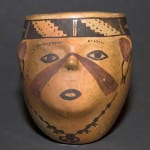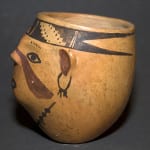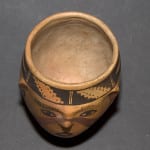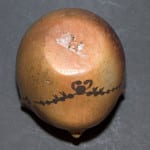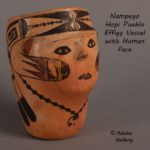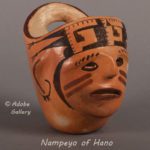This asymmetric Hopi effigy vessel has a molded human face, black and red painted facial features, headband, and ornamentation. The chin is pressed from the inside; the ears, eyebrows, and nose are applied. The painting is careful and delicate. It is unsigned but attributed to Nampeyo, ca 1900–1905.
During a visit to his home on 4/23/09, Ed Wade identified this jar as one made by Nampeyo. Wade believes Nampeyo made these effigy pots, other figural pots, and some candlesticks in 1905 during her first trip as a demonstrator at Hopi House, the Grand Canyon. Wade says that Herman Schweizer or John F. Huckel of the Harvey Company requested Nampeyo produce figurative items because he thought they would appeal to tourists who visit the Canyon. Apparently, Nampeyo complied for a short time and then went back to making her regular bowls and pots. For a discussion of Nampeyo and her time at the Harvey Company’s “Hopi House,” see Kramer (1988:46-53).
In July, 2009 Wade evaluated 2007-16 based on the website photos:
Among the least well known objects produced by Nampeyo were effigies in the form of mythic animals and, rarest of all, full figurines and human heads. The best documented of such pieces are a set of four human figures collected in 1922 by the Quapaw Bath House in Hot Springs, Arkansas, though it is likely the objects were made prior to this purchase date. The Quapaw effigies are unusual since they were intended to be realistic and anatomically correct likeness of human bodies, whereas the majority of other Nampeyo head effigies could best be described as sculpted figurative jars with open mouth craniums. In other words they were intended as decorative receptacles for things to be placed within.
In recent years a number of these “heads” have been found in private collections which bear the hexangular Fred Harvey House inventory stickers attached to them stating that the pieces were made on the Hopi Mesas and by the famous Hopi potter Nampeyo. All of these effigies share distinctive traits with the head pictured above.
First, the heads are tilted back from the neck at about a 20-degree angle conveying the impression that the figure is praying or singing. There are two sculpted facial planes, which are stair-stepped. The chin, mouth and everything up to the eyebrows occupy a recessed surface intersected by the nose and with the forehead cantered above. The nose creates a T-like bridge. The countenances of these vessels exhibit a similarity to the austere and aloof faces of ancient Cycladic sculpture.
The stepped facial planes are consistent with traditional Hopi sculpting of wooden god images and clay depictions found at 15th century Awatovi Pueblo.The eyes are domed and outlined by black painted lozenges. Ears are pinched semi-circles and typically painted red. As with lugs on canteens by Nampeyo, they sit two-thirds up the height of the vessel. Various decorative embellishments such as necklaces and earrings are common features of the form, and particularly headbands, which emphasize geometric motifs seen on the artist’s painted jars and bowls.
–Edwin L. Wade
Also see Wade’s comments in Wade and Cooke (2012:133). Writing about another effigy bottle for sale by Adobe Gallery (2008), Wade wrote, “For a brief period at the turn of the 20th century [Nampeyo] experimented with decorative effigy bottles, incorporating her classical feather motifs….” [Evaluation on file.] A second Nampeyo effigy jar was available at Adobe Gallery in July, 2022 and a third in October 2022:
Marti Streuver owned two similar effigy pots, one of which is documented as having been bought directly from Nampeyo. Several “rain gods” by Nampeyo are shown in Kramer (1996:158).
In 2013 a miniature version of this effigy, also by Nampeyo, became available on Ebay and joined my collection (2013-14). Several months later a second small effigy was for sale on Ebay by the same seller, but I controlled my greed and introduced the seller to this website.


